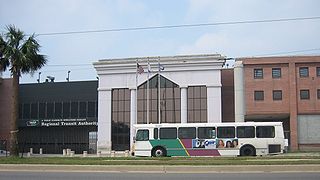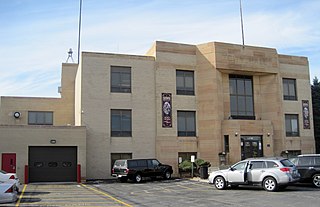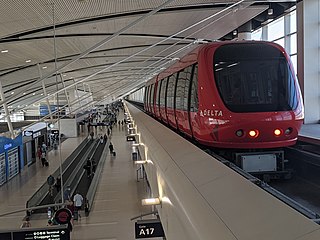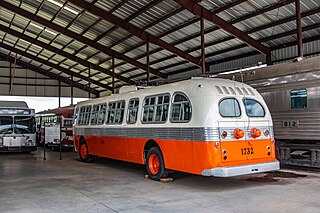History
The Chicago and West Towns Railway Co. (West Towns) was incorporated on July 15, 1913, to buy streetcar lines in suburban Cook County. [1] It included tracks in an area between Chicago Ave. on the North, the Chicago city limits on the East, Ogden Ave. on the South, and as far West as La Grange. They would go on to buy several bus companies in the 1930s and expand their own bus service, which would replace all streetcars by 1948. They renamed themselves the Chicago and West Towns Bus Co. in 1956. In 1963 they bought Leyden Motor Coach Co., in 1981 they were bought by the RTA, and in 1985 they were merged into the Pace West Division.
Background
In the 1881 financier Charles T. Yerkes began buying a number of streetcar lines, by 1900 he had a near monopoly of streetcars (and rapid transit) on Chicago's North Side, West Side, and Near West suburbs. He created a complex maze of corporations, often with questionable financing and business practices. All of West Towns' predecessor companies had been controlled by Yerkes interests. [5] [6] [8]
When Yerkes sold most of his Chicago interests and moved away in 1899 he left a network of financially weak companies behind. [9] Chicago began to re-organize their streetcar services. The Consolidated Traction Ordinance of October 10, 1910, required the Yerkes suburban lines to be separated from their Chicago operations. [10]
On November 21, 1910, the suburban streetcar lines were bought by County Traction Co., who then bought the Suburban Railroad (a separate Yerkes company) on February 27, 1912, and was sold to the non-Yerkes West Towns On December 27, 1913.
The beginning
The West Towns was incorporated on July 15, 1913. It was organized by John J. Cummins and his brother Walter J. Cummings was its first president. They owned a streetcar manufacturing company and were familiar with the business. John sometimes called the purchase price a "joke". Despite the problems he was able to organize the company and make a profit every year until 1931, after the Great Depression began.
The West Towns had different operating conditions than adjoining Chicago as a smaller system through less densely populated areas. Fares were usually more expensive for inferior service. Many of the lines were originally connected with Chicago routes until 1910, when Chicago's ordinance separated them. With no fare or transfer arrangement with Chicago a passenger would have to walk to change cars and then pay a separate, and higher, West Towns fare in order to continue traveling on the same street outside the city.
They ran through a number of different suburbs and needed franchises with each one. The different suburbs often had different interests and negotiated individually so one suburb could jeopardize service for others.
Many of the lines had been built in "streetcar suburbs", where the streetcars are run through largely undeveloped area, counting on the service to create development and new passengers. This is an advantage to the developer but requires running a low-rider line until the development happens.
Streetcars
County Transit was not operating when it was bought, a labor strike had stopped all service. Management met the union's demands for equal pay as Chicago streetcar employees.
Arrangements for franchises were made except with Forest Park, who was a problem for the West Towns. At the same time $290,750 was spent on improvements to infrastructure. On July 13, 1913, partial operation resumed.
Into the 1920s the suburbs continued to negotiate separately. In 1923 the Illinois Commerce Commission ruled that the individual suburbs had no control over routes and the West Towns would now deal directly with the Illinois Commerce Commission. With the new Ill.C.C. ruling the West Towns began applying for new routes, most with buses. They petitioned for ten new routes in 1923, eight more in 1925, and four more in 1926. From two buses in 1923 the West Towns went to 46 in 1930.
In 1929 the great depression caused net income to fall from $138,080 in 1929 to -$37,982 in 1931. The company went into bankruptcy and was reorganized as the "Chicago and West Towns Railway Incorporated". The company survived but continued to lose money all through the 1930s.
1935 showed a change to buses coming. In 1934 streetcar trackage was at its maximum, 479.65 miles (771.92 km) miles, in 1935, with the purchase of 27 buses, trackage was reduced to 73.1 miles (117.6 km). From this time on streetcar service would be replaced with busses, the last streetcars ran in 1948.
On December 2, 1936, a fire at the Lake St. car-barn burned 18 passenger cars and some other equipment. The West Towns leased six streetcars from Chicago Railways (a former Yerkes Chicago company) between December 2, 1936, and returned March 14, 1937.
In 1941 World War II war production and ridership increased, net earnings went from -$87,843 in 1941 to $377,433 in 1943 (the best year in the history of the company).
Because of the war many routes were changed and new ones were added. Operations were changed, stops were reduced, and a new garage was opened to reduce mileage of the buses.
West Towns began buying 27-passenger buses in 1941 and the War Production Board approved continued sales from 1942 until 1945, the last order was filled in 1946. In 1944 32, 36, and 38 passenger models began arriving and continued until 1950.
Buses take over
After World War II the West Towns, which had been neglected in the 1930s then used to maximum capacity during the war, was worn out. The rolling stock, both streetcars and buses, needed replacing and the infrastructure need major repairs and upgrades. Like most other streetcar systems in the US, the cost was not practical and all streetcars were replaced with buses by 1948.
With the number of replacement buses needed nationally larger 44/45 (35 ft (10.67 m) long) and 51 (40 ft (12.19 m)) long passenger models were an advantage. West Towns only bought 45 passenger buses new after 1949, when the first GMC TDH4509 "old look"" series arrived. They later bought used 53 passenger and narrow models.
On November 29, 1956, with the end of streetcar service, the company was renamed The Chicago and West Towns Bus company.
In the 1960s the GMC TDH-4517 and -4519 "new look" series became the standard buses and other makes or models were bought used. In 1963 and 1964, at the time Leyden was acquired, they bought 19 used TDH-4509s.
In 1963 Leyden Motor Coach was bought. They had often longer routes north and west of the West Towns. Leyden had a route west to Wheaton in DuPage County and north to O'Hare Airport.
In the 1970s action for public operation began. March 19, 1974 a referendum was passed creating the RTA and on June 28, 1974, the last legal challenge to the RTA was decided by the Illinois Supreme Court. On December 19, 1974, the West Towns received their first $149,000 and would receive increasing amounts through 1978. The structure of the RTA, financing the private companies, failed. On May 30, 1881, all service was stopped on the West Towns until August 5, when reduced service resumed with a third of the drivers working.
In November 1981 the RTA purchased the West Towns, and began operating it with management company ATE, who owned and operated a number of bus companies nationwide. This didn't fix the problems, the RTA was restructured in 1983 and the West Towns became the Pace West Division. After seventy years the West Towns was no longer in business.
The companies
The Cicero and Proviso Railway was incorporated on February 15, 1889. The first West Towns company, they would serve the area of Cicero and Proviso townships. Their first route was a horsecar line on Madison St. with a loop north to Lake St. Electric power began on February 12, 1891. Both Madison and Lake Sts. would be extended and a number of other lines were added, by 1895 they had 17.92 miles of track, most double-tracked. It was bought by Consolidated Traction on February 27, 1899, spun-off to County Traction on December 27, 1910, and bought by the West Towns in 1913.
The Ogden Street Railway was incorporated on October 1, 1891, to serve an area around Ogden Ave. west to Lyons. It was bought by Consolidated Traction on February 27, 1899, spun-off to County Traction on December 27, 1910, and bought by the West Towns in 1913.
The Suburban Railroad Company was incorporated on May 17, 1985, as an electric railroad, or interurban, not a street railway. They built the LaGrange line, originally from Cicero Ave. and Harrison St. west to Harlem Ave., later they would route it on Cermak Rd. from Cicero Ave. west to Harlem Ave., then south They also had a north–south line on Laramie Ave. The Suburban was bought by County Traction on February 27, 1912, and became part of the West Towns in 1913.
The Chicago Consolidated Traction Co. was incorporated on February 29, 1899, to unify eight streetcar companies (seven were controlled by Yerkes). As a result of the Traction Ordinance of 1910 they sold their operations to County Traction (outside Chicago) and Chicago Railways (inside Chicago) on December 27, 1910.
The County Traction Co. was incorporated on November 21, 1910, to buy the Yerkes suburban streetcar operations from Consolidated Traction Co. On February 27, 1912, they also bought the separate (but still a Yerkes company) Suburban Railroad. It was sold and merged into the West Towns in 1913.
Speedway Auto Bus Co. was incorporated on July 1, 1921, to serve the new government hospital (named Edward Hines Jr. Hospital on October 31, 1921) in the area called "Speedway" after a race-track that was there before World War I. It opened the line On September 9, 1921. In June 1922 they extended service before they had permission from the Illinois Commerce Commission. Their application, and five later ones, were all contested and denied. They could operate charter service but Hines was their only regular route. They were bought by the West Towns on May 5, 1930.
Metropolitan Motor Coach Co. (the Marigold Line) started with two small companies providing local service in Oak Park. Northwestern Transit bought Oak Park Motor Transport in 1921 when both companies were only months old. They served local streets that were not served by the West Towns. In 1928 both companies were bought by Metropolitan and in 1935 they were merged. Never very profitable, Metropolitan was sold to the West Towns on September 5, 1935.
Leyden Motor Coach operated express routes north of The West Towns and the two companies sometimes competed for routes. Leyden was seized by the federal government for unpaid taxes in 1963 and the Illinois Commerce Commission issued an emergency order for the West Towns to acquire them. The West Towns started operating Leyden routes on August 7, 1963. [28]
Regional Transportation Authority (RTA) was created on December 13, 1973, to fund area transit districts and private companies. At first it just funded the private companies, but that led to large cost-over-runs and a funding crisis. All service on the West Towns stopped on May 30, 1981, and less than half the service was restored on August 5. In November 1981 the RTA bought the West Towns and had ATE Management operate it, but the funding crisis continued. In 1983 the RTA was completely re-organized with all the bus companies merged into the Pace West Division. [29] [30]
ATE Management and Service Co. (ATE) is a spin-off from a holding company for buses. They were hired in 1981 to operate the RTA's suburban bus companies. [31] [32]
Pace is the brand name of the Suburban Bus Division of the RTA. In 1983 it began operating all suburban buses. [33] Some West Towns routes have continued in service, often with their West Town's route number placed in the 300 series.
Routes
(Not all are shown)
Route #2 - Berwyn-Lyons was opened by the Ogden Street Railroad in 1893. From 25th St. and Cicero Ave. in Cicero it went west on 25th St. to Central Ave., where it jogged one block south and continued west on 26th St. to Ridgeland. On Ridgeland they went south to Stanley, southwest to Harlem Ave., and south to Ogden Ave. On Ogden Ave. the line went west to Lawndale Ave. and a connection with the Chicago and Joliet Electric Railway in Lyons.
Route #4 - La Grange was opened by Suburban Railway Co. in 1895. From just east of Cicero Ave. it went west on 22nd St. (now Cermak Rd.) to Harlem Ave., south to 26th St., and west to Des Plaines Ave. At Des Plaines Ave. it went south and continued on Woodside Rd. to Park Place, where it turned west onto private right-of-way. It crossed the Des Plains River, First Ave., and ran through an undeveloped area. In 1934 the area north of the line would become Brookfield Zoo, a high traffic weekend destination. The tracks crossed Salt Creek and went west through a streetcar suburb section of Brookfield, down the median on Monroe Ave., southwest through "Eight Corners" on Broadway Ave., and west on Lincoln. After crossing the Indiana Harbor Belt Railroad the route turned south and ran on private right-of-way along the tracks through La Grange Park and into La Grange. At Hillgrove Ave. the line turned west and ended at Brainard Ave. The line was converted to buses on April 4, 1948. Buses ran west on Cermak until Harlem Ave. but then went south on Harlem to 26th St., west to Des Plaines Ave., south to 31st St and west to 1st Ave. There the buses turned south and ran next to Brookfield Zoo south to Washington St. in Brookfield. Washington St. runs west and turns into Harding Ave. in La Grange Park. At La Grange Rd. the line turned south to La Grange and at Hillgrove it went west to Brainard Ave. [36]
Route #8 - Veteran's Hospital Edward Hines VA Hospital has had bus service to the Forest Park rapid transit station since it was opened in 1921. Speedway Auto Bus Co. started a route from the Forest Park terminal south to 12th St. (now Roosevelt Rd.) and west to the hospital. Leaving the hospital the route went north on 5th Ave to the C&NW (now UP)'s Maywood commuter station near Lake St. Over time the routing has changed and sometimes been combined with other routes, in 2023 Pace route "308 Medical Center" connects Hines and the adjacent Loyola University Medical Center with the Forest Park terminal.
Route #9 - Lake St. Lake St. was part of the Cicero and Proviso's first horsecar loop with Madison St. Tracks on Lake St. extended from Austin Bvld. west to 25th Ave. in Melrose Park. In 1947 it was converted to buses and extended to Wolf Rd. in Northlake.
Route #10 - Madison St. Madison St. between Pulaski Ave. and Harlem Ave., with a loop north to Lake St., was the Cicero and Proviso Street Railway's first line, opened in 1890. This was a horse-car line until electrified in 1891. From that time both Madison St. and Lake St. would become major lines. In tracks went from Austin Bvld. as far as 19th Ave. in Maywood. The line was converted to buses on February 16, 1947, and later extended to La Grange Rd. [40]
Route #13 - St. Charles Rd./Wheaton was a Leyden Coach route. It served the customers of the Chicago Aurora and Elgin Railroad, which ended service on July 3, 1957. It went from Lake St. near Harlem Ave. west to St. Charles Rd. and farther west to Crescent Bvld. and Pennsylvania Ave. through Glen Ellyn. In Wheaton Pennsylvania Ave turns into College Ave. which connects to Seminary Ave., all westbound. At Cross St. it turned south, crossed the Chicago and Northwestern RR., and looped east one block to the DuPage County courthouse at Liberty Dr. and Reber St. [42]
Route #14 - O'Hare–Chicago Loop was a Leyden route. The eastern terminal was near the Chicago Loop, it used Garvey Ct. north to Wacker, and then west out Randolph/Washington to Homan, then jogged onto Madison St. and west to Harlem Ave. On Harlem Ave. it went north to Grand Ave., west to Rose in Franklin Park, north into Ruby St. in Shiller Park. At Lawrence Ave. the line went west to Mannheim Road and north to O'Hare International Airport.














